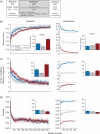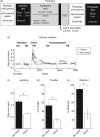Locomotor adaptation
- PMID: 21741544
- PMCID: PMC3738197
- DOI: 10.1016/B978-0-444-53752-2.00013-8
Locomotor adaptation
Abstract
Motor learning is an essential part of human behavior, but poorly understood in the context of walking control. Here, we discuss our recent work on locomotor adaptation, which is an error driven motor learning process used to alter spatiotemporal elements of walking. Locomotor adaptation can be induced using a split-belt treadmill that controls the speed of each leg independently. Practicing split-belt walking changes the coordination between the legs, resulting in storage of a new walking pattern. Here, we review findings from this experimental paradigm regarding the learning and generalization of locomotor adaptation. First, we discuss how split-belt walking adaptation develops slowly throughout childhood and adolescence. Second, we demonstrate that conscious effort to change the walking pattern during split-belt training can speed up adaptation but worsens retention. In contrast, distraction (i.e., performing a dual task) during training slows adaptation but improves retention. Finally, we show the walking pattern acquired on the split-belt treadmill generalizes to natural walking when vision is removed. This suggests that treadmill learning can be generalized to different contexts if visual cues specific to the treadmill are removed. These findings allow us to highlight the many future questions that will need to be answered in order to develop more rational methods of rehabilitation for walking deficits.
Copyright © 2011 Elsevier B.V. All rights reserved.
Figures




Similar articles
-
Using a Split-belt Treadmill to Evaluate Generalization of Human Locomotor Adaptation.J Vis Exp. 2017 Aug 23;(126):55424. doi: 10.3791/55424. J Vis Exp. 2017. PMID: 28872105 Free PMC article.
-
A single exercise bout and locomotor learning after stroke: physiological, behavioural, and computational outcomes.J Physiol. 2018 May 15;596(10):1999-2016. doi: 10.1113/JP275881. Epub 2018 Apr 17. J Physiol. 2018. PMID: 29569729 Free PMC article.
-
Gait speed influences aftereffect size following locomotor adaptation, but only in certain environments.Exp Brain Res. 2016 Jun;234(6):1479-90. doi: 10.1007/s00221-015-4548-6. Epub 2016 Jan 20. Exp Brain Res. 2016. PMID: 26790424
-
Neurophysiologic and rehabilitation insights from the split-belt and other locomotor adaptation paradigms.Phys Ther. 2010 Feb;90(2):187-95. doi: 10.2522/ptj.20090073. Epub 2009 Dec 18. Phys Ther. 2010. PMID: 20023001 Free PMC article. Review.
-
The Split-Belt Walking Paradigm: Exploring Motor Learning and Spatiotemporal Asymmetry Poststroke.Phys Med Rehabil Clin N Am. 2015 Nov;26(4):703-13. doi: 10.1016/j.pmr.2015.06.010. Epub 2015 Sep 26. Phys Med Rehabil Clin N Am. 2015. PMID: 26522907 Free PMC article. Review.
Cited by
-
Walking adaptability after a stroke and its assessment in clinical settings.Stroke Res Treat. 2014;2014:591013. doi: 10.1155/2014/591013. Epub 2014 Aug 28. Stroke Res Treat. 2014. PMID: 25254140 Free PMC article. Review.
-
Considering the response in addition to the challenge - a narrative review in appraisal of a motor reserve framework.Aging (Albany NY). 2024 Mar 18;16(6):5772-5791. doi: 10.18632/aging.205667. Epub 2024 Mar 18. Aging (Albany NY). 2024. PMID: 38499388 Free PMC article. Review.
-
Frontal plane dynamics of the centre of mass during quadrupedal locomotion on a split-belt treadmill.J R Soc Interface. 2020 Sep;17(170):20200547. doi: 10.1098/rsif.2020.0547. Epub 2020 Sep 9. J R Soc Interface. 2020. PMID: 32900302 Free PMC article.
-
A Spinal Mechanism Related to Left-Right Symmetry Reduces Cutaneous Reflex Modulation Independently of Speed During Split-Belt Locomotion.J Neurosci. 2018 Nov 28;38(48):10314-10328. doi: 10.1523/JNEUROSCI.1082-18.2018. Epub 2018 Oct 12. J Neurosci. 2018. PMID: 30315129 Free PMC article.
-
Feasibility of visual instrumented movement feedback therapy in individuals with motor incomplete spinal cord injury walking on a treadmill.Front Hum Neurosci. 2014 Jun 12;8:416. doi: 10.3389/fnhum.2014.00416. eCollection 2014. Front Hum Neurosci. 2014. PMID: 24987344 Free PMC article.
References
-
- Cothros N, Wong J, Gribble PL. Visual cues signaling object grasp reduce interference in motor learning. Journal of Neurophysiology. 2009;102:2112–2120. - PubMed
Publication types
MeSH terms
Grants and funding
LinkOut - more resources
Full Text Sources
Medical

